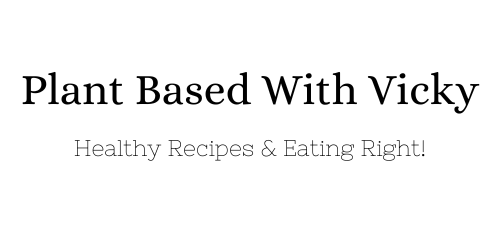Mastering Meal Prepping: Learn Simple Tips for Starting A Plant Based Diet


Disclosure: Articles may contain affiliate links. As an Amazon Associate, we earn from qualifying purchases (at no additional cost to you). See our full disclosure here.
A plant-based diet is an exciting journey and one with amazing health benefits. You should be proud and excited, however transitioning to a plant-based diet can be a daunting task, especially if you’re used to the standard American diet. Many people find giving up cheese and dairy harder than actually giving up meat.
Ease into your new way of eating and make sure not to be to hard on yourself if you slip up. It’s a learning process and a life style change not just a diet. After a few months, your new way of eating will be easy and natural.
Why Plant-Based?
Plant-based diets are gaining popularity for several compelling reasons:
1) Improved Health– more and more studies are proving that a plant based diet can reduce the risk of chronic diseases such as heart disease, diabetes, and certain types of cancer. It’s rich in vitamins, minerals, and antioxidants while being low in saturated fats and cholesterol.
2) Environmental – Choosing plants over animal products can help reduce greenhouse gas emissions and support sustainable food systems.
3) Ethical Considerations- Many people adopt a plant-based diet to align with their ethical beliefs and concerns about animal welfare. By eliminating or reducing animal products, you can contribute to the well-being of animals.
The Importance of Meal Prepping on a Plant-Based Diet
Meal prepping is not just a convenient way to ensure you have healthy meals at your disposal; it’s a crucial tool for success on a plant-based diet for several reasons:
1) Time-Saving– Preparing meals in advance can save you time during busy workdays. No more last-minute scrambling to find plant-based options.
2) Cost-Effective–Eating out or buying pre-made plant-based meals can be expensive. Meal prepping allows you to control your food budget. With the high cost of food these days, eliminating dairy and meat from your diet will save you a lot of money at the grocery store.
3) Variety–With thoughtful meal prepping, you can enjoy a diverse range of plant-based recipes and prevent monotony.
Now, let’s explore the step-by-step process of meal prepping for your plant-based journey.

Step 1: Plan Your Meals
The first step in successful meal prepping is planning your meals. This involves deciding what you’ll eat for breakfast, lunch, dinner, and snacks throughout the week. Here are some tips to get started:
1) Create a Weekly Menu– Begin by listing the meals you want to prepare for the week. Include a mix of your favorite plant-based dishes, and consider trying new recipes to keep things interesting.
2) Balance Nutrients– Ensure that your meals include a balance of carbohydrates, proteins, and healthy fats. Incorporate a variety of colorful fruits and vegetables to get a wide range of vitamins and minerals.
3)Portion Control– Plan your meals to meet your dietary goals and portion sizes. This helps prevent overeating and food waste.

Step 2: Make a Shopping List
Once you’ve planned your meals, create a shopping list of all the ingredients you’ll need. I have written a post on stocking your pantry that you may find helpful. Here are some shopping tips:
1) Check Your Pantry–Before heading to the store, take stock of what you already have at home. This prevents you from buying duplicate items.
2) Buy in Bulk– Purchase staple items like rice, beans, pasta, and canned goods in bulk to save money and reduce packaging waste.
You can buy many frozen fruits and vegetables in large bulk sized from places like Costco and Sams. Frozen vegetables and fruits are just as nutritious as fresh and can save you a lot of money.

Step 3: Prep Your Ingredients
Now it’s time to roll up your sleeves and prep your ingredients. This step can vary depending on your preferences and schedule. Here’s what you can do:
1) Wash and Prep– Clean and chop your fruits and vegetables, so they’re ready to use in recipes. You can store them in airtight containers or reusable produce bags to keep them fresh. I also use mason jars with some water in the bottom to store cut carrots and celery. This also works for fresh herbs like parsley and cilantro. Your fresh ingredients will stay fresher longer.
2) Cook in Batches– Prepare large batches of grains like rice, quinoa, or pasta and store them in the fridge for easy access throughout the week. Mason jars are great for keeping cooked grains and legumes in. I also use them to keep fresh herbs in the refrigerator.
3) Make Sauces and Dressings– Whip up plant-based sauces, dressings, or dips that can enhance the flavor of your dishes. Store them in jars or containers.
4) Protein Sources– If you’re including tofu, tempeh, or legumes in your meals, cook them in advance and store them in portion-sized containers.
Step 4: Assemble Your Meal
With your ingredients prepped and ready, it’s time to assemble your meals. Here are some meal prepping ideas and recipes to get you started:
Breakfast:
- Overnight oats with almond milk, chia seeds, and fresh berries.
- Smoothie packs: Pre-pack your favorite smoothie ingredients in freezer bags for quick morning blending.
Lunch:
- Veggie wraps with hummus, roasted vegetables, and greens.
- Quinoa salad with chickpeas, cucumber, and a lemon-tahini dressing.
Dinner:
- Vegetable stir-fry with tofu and a savory ginger-garlic sauce.
- Spaghetti with marinara sauce, sautéed mushrooms, and a sprinkle of nutritional yeast.
Snacks:
- Sliced cucumbers and carrots with homemade tzatziki sauce.
- Trail mix with nuts, dried fruits, and dark chocolate chips.
Step 5: Store Properly
Proper storage is essential to keep your prepped meals fresh and safe to eat. Use a variety of containers like glass jars, reusable silicone bags, and airtight containers to store your meals in the fridge or freezer. Remember these storage tips:
1.Label and Date–Label your containers with the date of preparation to ensure you use them within a safe timeframe.
2.Portion Control– Divide your meals into single servings to make it easy to grab and go.
3.Freeze Wisely– If you’re meal prepping for an extended period, freeze some portions to maintain their freshness. Be sure to use freezer-safe containers.
4.Stack Smartly– Organize your fridge or freezer with the oldest meals at the front to avoid food waste.
Step 6: Stay Flexible
While meal prepping offers structure and convenience, it’s important to remain flexible. Life can be unpredictable, and you might find yourself with unexpected plans or cravings. Embrace the flexibility of your plant-based journey and adapt your meal prepping accordingly.
Remember that meal prepping doesn’t have to be a daunting task. Start small, experiment with recipes, and find a routine that works for you. Over time, you’ll become more proficient at planning, prepping, and enjoying delicious plant-based meals.
